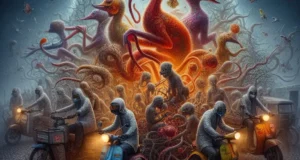In the shadowy corridors of history, there lies a room seldom entered—a chamber not of war or politics, but of medicine gone awry. It is here that the “Colonial Needle Nexus” silently exists: a haunting intersection of well-meaning intervention and unintended consequence. And at the heart of that room lies a question still echoing through decades: AIDS—where did it come from?

To understand this nexus, imagine a scalpel not of steel, but of empire. In the first half of the 20th century, European colonial powers swept through Central and West Africa, bringing with them grand ambitions of civilization, control—and healthcare. With white coats and medical kits, they launched mass injection campaigns against diseases like sleeping sickness, yaws, and syphilis. But while their intentions may have aimed at salvation, their instruments carried seeds of devastation.
Picture a metal syringe, gleaming under the African sun, used again and again—sometimes on hundreds in a single day. Boiled when possible, but often hurriedly wiped or simply reused. The same needle that saved one life might unknowingly have passed something invisible—something waiting to awaken. This is the silent setting of the Colonial Needle Nexus, where unsterilized medical practices became the unwitting midwives of a modern plague.

Now return to the persistent question: AIDS—where did it come from? Science tells us HIV originated from SIV, a virus harbored by chimpanzees. The leap from primate to human likely occurred during bushmeat hunting—blood mingling in wounds. But a leap is not enough. Viruses need amplification. They need access points, networks—vectors. And colonial medicine, with its mass injection campaigns, offered HIV just that.
In towns and villages, patients lined up for treatments. A single needle would pierce the skin of child, elder, hunter, and mother alike. Without proper sterilization, blood from one became blood in all. If even one among them had acquired the early form of HIV, the syringe became a needle of multiplication.
The Colonial Needle Nexus doesn’t accuse—it reveals. It shows how the very instruments meant to heal were hijacked by an emerging virus. They formed a bridge not just between bodies, but across time—carrying the virus from isolated rural infections to wider human populations, long before the world had a name for it.
By the time HIV was formally recognized in the 1980s, the virus had already been spreading, mutating, and embedding itself in the human population for decades. The early transmissions, likely fueled by colonial-era injection practices, went unnoticed. Silent. Invisible. Yet every reused needle was a whisper in the dark, inching the world closer to the epidemic that would later scream across headlines.
So when we ask “AIDS where did it come from”, we must look beyond the forest, beyond the primates. We must step into that historical clinic where time moved fast and sterilization moved slow. The answer may not lie solely in blood or biology—but in brass syringes, colonial urgency, and forgotten protocol.
The Colonial Needle Nexus serves as both explanation and warning. It reminds us that the tools of healing can also harm when wielded without caution. It teaches us that viruses do not always need war or famine to spread; sometimes, they only need a syringe and a system unprepared to recognize the risks.
In the story of AIDS, this nexus is one of the earliest, quietest chapters. But its role is crucial. Because it was here, perhaps more than anywhere else, that HIV found the means to become a pandemic.




